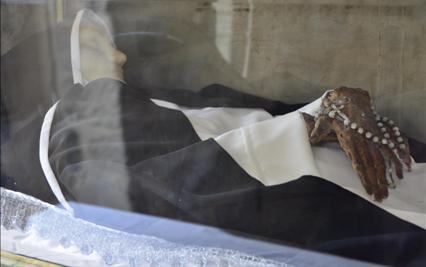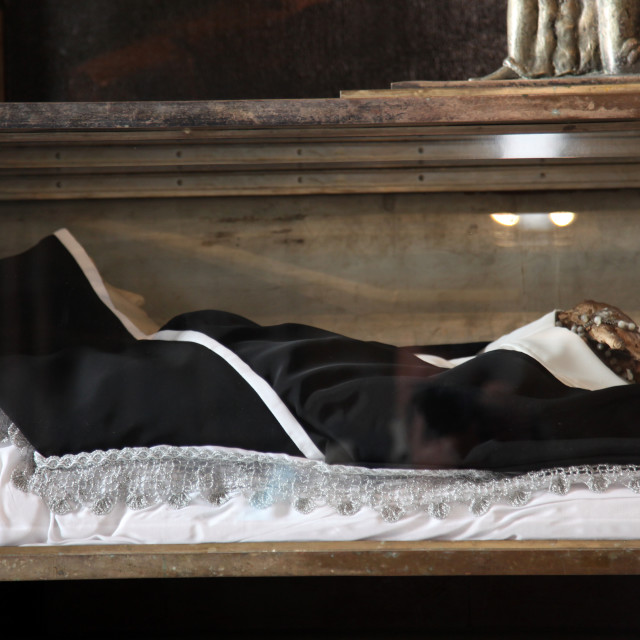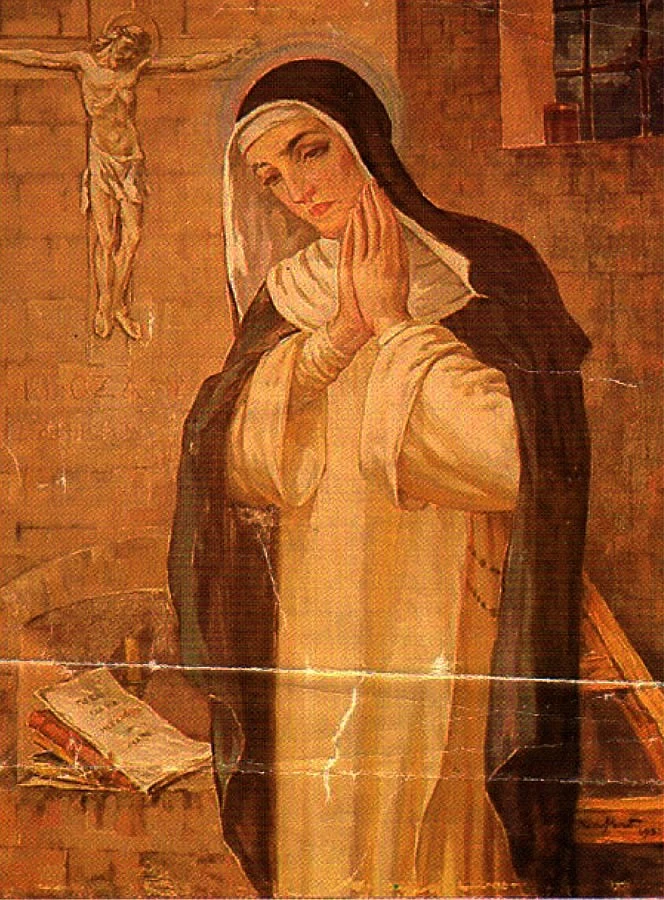dominican saints
Bl. Hosanna of Catharo, V.O.P.


Feast Day: April 27th
Born: 1493 at Kumano, Montenegro as Catherine Cosie
Died: 1565 of natural causes
Beatified: 1928 (cultus confirmed); 1934 (beautified)
Representation: In art, Osanna is a Dominican tertiary wearing a crown of thorns, surrounded by rays of light (not the halo of a saint), a lily, a broken heart with a crucifix springing from it, the devil under her feet, two angels (one with a lily, one with a cross). This is similar to the image of Saint Catherine of Siena, who has a halo. Osanna is the patroness of school girls.
Catherine Kosic (Cosie) was baptized in the Greek Orthodox Church. As a young girl, when tending her family’s sheep; thus, left alone for long periods of time, she developed a habit of contemplative prayer. One day while watching the flocks, she saw a pretty child lying asleep on the grass. Attracted by its beauty, she went to pick up the baby, but it disappeared, leaving Catherine with a feeling of great loneliness.
She told her mother about the incident but received little understanding; her mother told her that God didn’t appear to such poor people, and that the Christ Child was simply a figment of her imagination. After several more apparitions of which she wisely said nothing, Catherine developed a desire to visit Cattaro because there were several churches there in which she felt that she could pray better. Her mother thought this urge was unreasonable, but she finally arranged for Catherine to go to Cattaro as a servant of a wealthy woman. Her mother gave little thought to the fact that the woman was a pious Catholic, but the girl rejoiced in her good luck. At the age of 12, Catherine settled down as a servant to the kindly woman who made no objection to the fact that Catherine’s errands invariably led her past the church, where she would stop for a visit.
After a few years of the pleasant life, Catherine consulted her spiritual director about becoming a recluse. He thought her too young, but she continued to insist. After much prayer and discussion, they decided that she should follow the life of a hermit. In the Middle Ages, it was common for every church or place of pilgrimage to have one or more cells in which solitaries dwelt in prayer and penance. Such a cell was built near the Saint Bartholomew’s in Cattaro. It had a window through which the anchorite could hear Mass and another tiny window to which people would come occasionally to ask for prayers or to give food. Catherine was conducted to her cell in solemn ceremony, and, after making promises of stability, the door was sealed.
In response to a vision, she was later transferred to a cell at the Church of St. Paul, where she followed the rule of the tertiaries of Saint Dominic for 52 years. Upon becoming a Dominican, she chose the name Osanna, in honor of Blessed Osanna of Mantua, a Dominican tertiary who had died in 1505. The life of an anchorite is barren of comforts and replete with penances. Even without the spiritual punishments that she endured, it was a rugged life. Osanna wore the coarsest of clothes, ate almost nothing, and endured the heat and cold and misery of enclosure in a small space for half a century. Her tiny cell, however, was often bright with heavenly visitors. Our Lord appeared to her many times, usually in the form of the beautiful baby she had seen while tending her flocks. Our Lady visited, too, with several of the saints, as well as demons who attempted to distract her from prayer. Once the devil appeared to her in the form of the Blessed Virgin and told her to modify her penances. By obedience to her confessor, she managed to penetrate this clever disguise and vanquish her enemy.
Although she lived alone, there was nothing selfish about Osanna’s spirituality. A group of her Dominican sisters, who considered her their leader, consulted her frequently and sought her prayers. A convent of sisters founded at Cattaro regarded her as their foundress, because of her prayers, although she never saw the place. When the city was attacked by the Turks, the people ran to her for help, and they credited their deliverance to her prayers. Another time, her prayers saved them from the plague (Benedictines, Dorcy).
Veneration
The incorrupt body of Osanna was kept in the Church of St. Paul until 1807, when the French Army converted the church into a warehouse. Her body was then brought to the Church of St. Mary. The people of Kotor venerated her as a saint. In 1905, the process for her beatification began in Kotor and was successfully completed in Rome. In 1927, Pope Pius XI approved her cultus, and in 1934, she was formally beatified.
Over the course of her life, the people of Kotor came to call her “the trumpet of the Holy Spirit” and the “teacher of mysticism.” People from all walks of life came to her for advice, and she interceded particularly for peace in the town and among feuding families.

Prayers/Commemorations
First Vespers:
Ant. This is a wise Virgin whom the Lord found watching, who took her lamp and oil, and when the Lord came she entered with Him into the marriage feast.
V. Pray for us Blessed Hosanna.
R. That we may be made worthy of the promises of Christ.
Lauds:
Ant. Come, O my chosen one, and I will place my throne in thee, for the King hath exceedingly desired thy beauty.
V. Virgins shall be led to the King after her.
R. Her companions shall be presented to Thee.
Second Vespers:
Ant. She has girded her loins with courage and hath strengthened her arm; therefore shall her lamp not be put out forever.
V. Pray for us Blessed Hosanna.
R. That we may be made worthy of the promises of Christ.
Let us Pray: Renew in our hearts, O Lord, the love of Thy Cross: that by the intercession and example of Blessed Hosanna, Thy penitential Virgin, we may become partakers in the Passion of Christ and His glory. Through our Lord. Amen.
